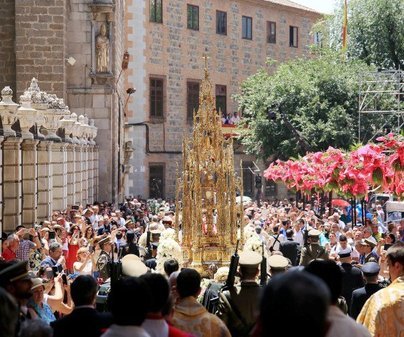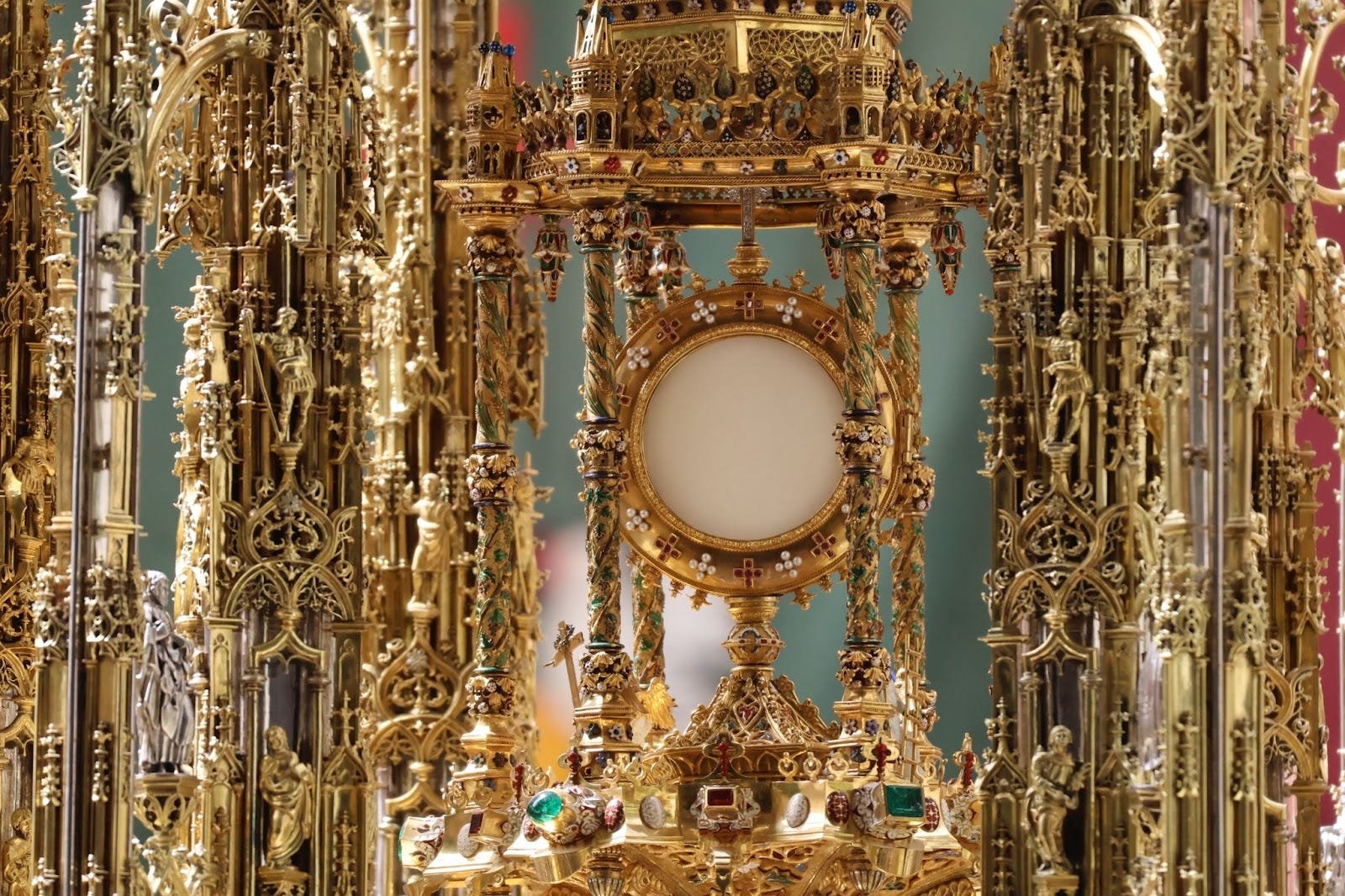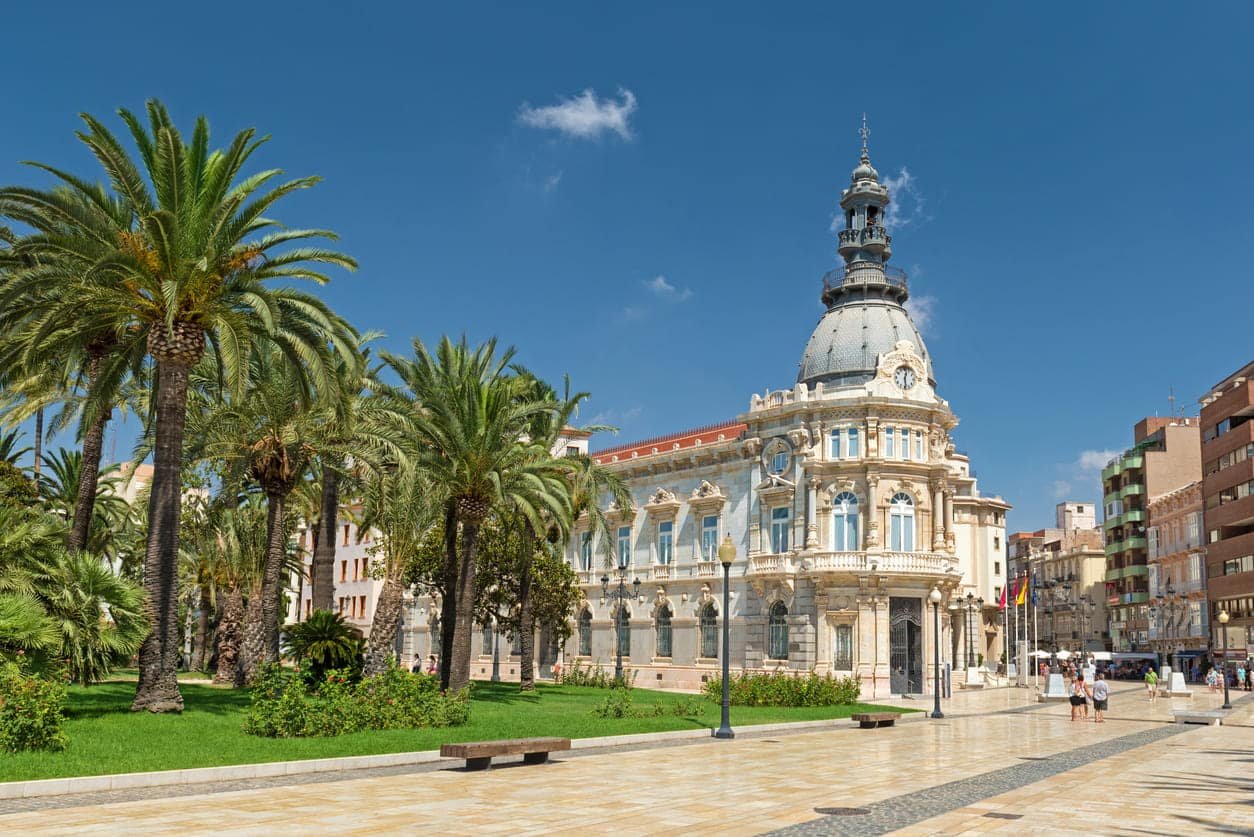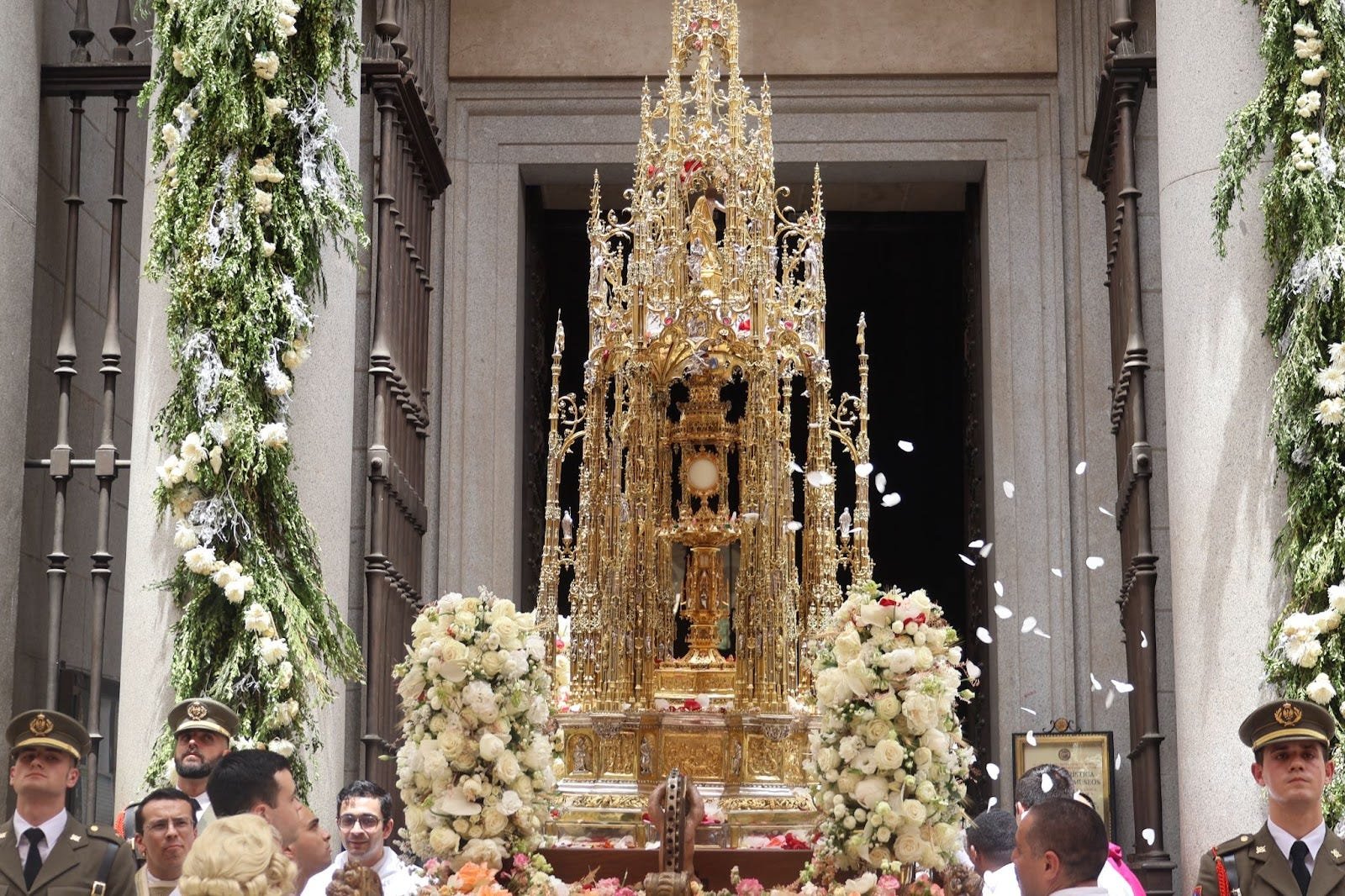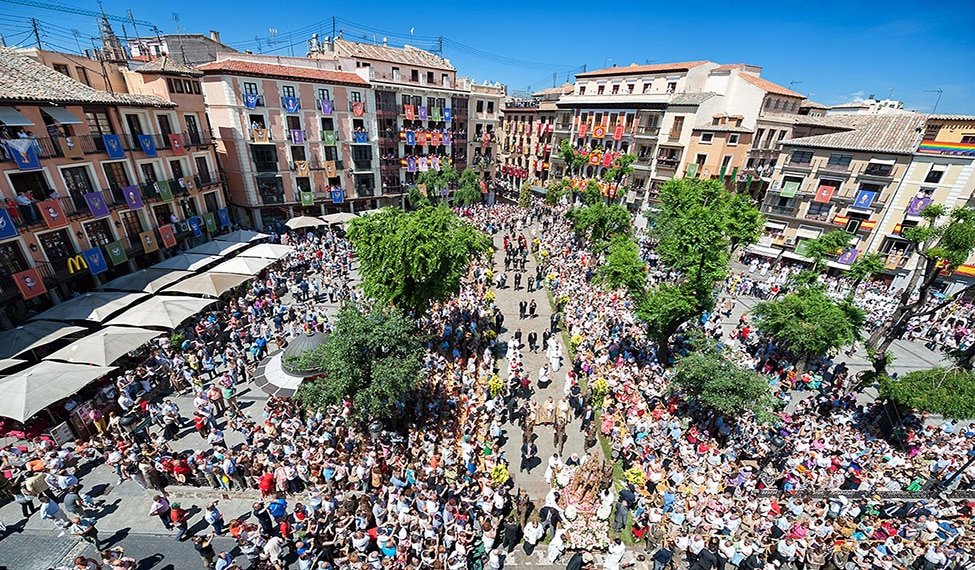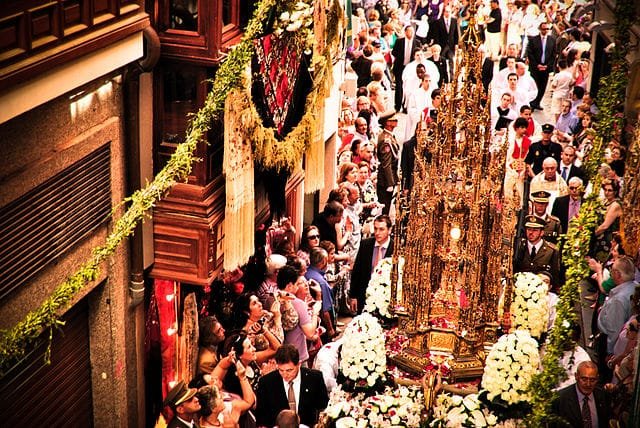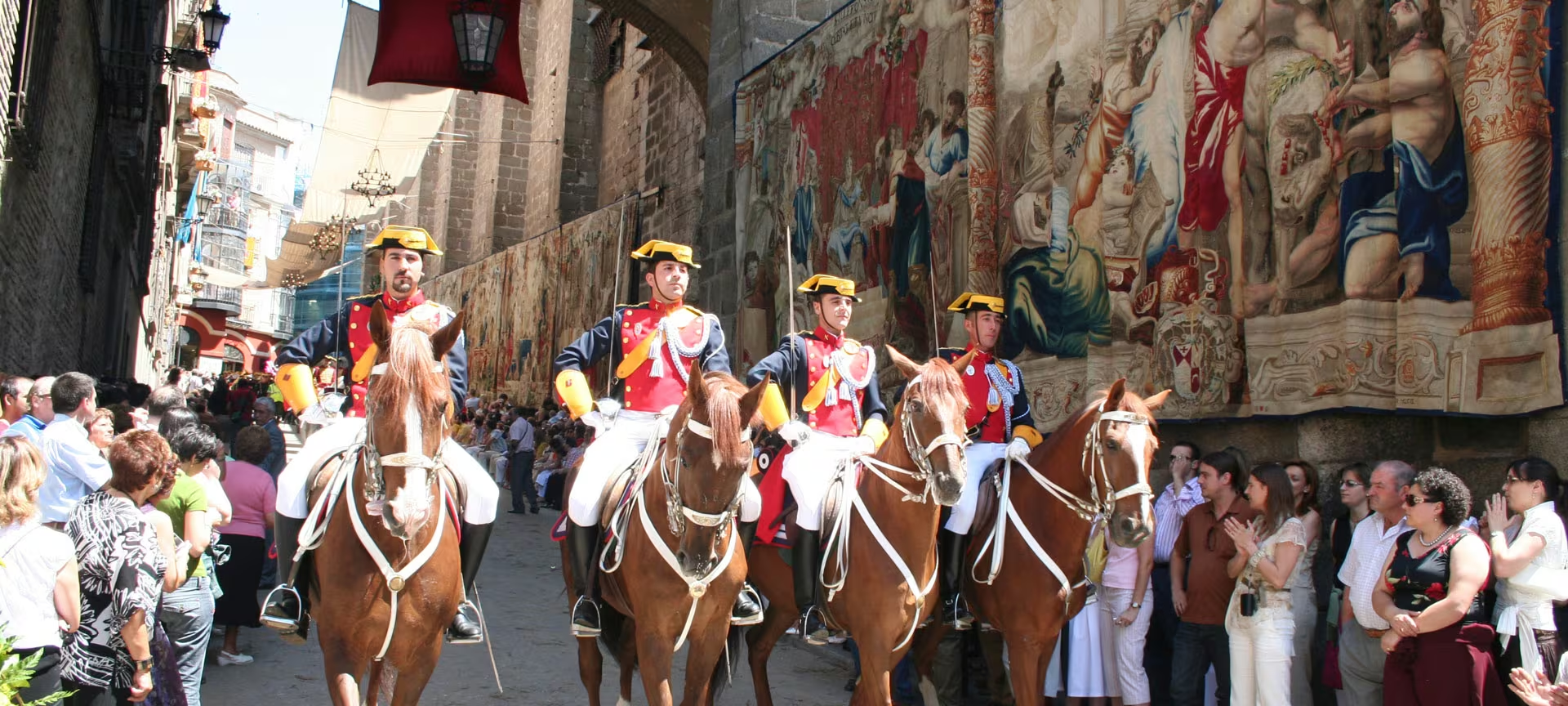Corpus Christi (Toledo, Spain) 2026
Background & History
Corpus Christi in Toledo, known as the “City of Three Cultures,” is Spain’s most iconic Eucharistic celebration, a solemn procession blending medieval piety, Renaissance artistry, and communal fervor that has adorned the imperial city’s streets since the 14th century. Rooted in the 13th-century institution by Pope Urban IV to honor the Real Presence in the Eucharist, it arrived in Toledo around 1264, but the first documented procession dates to 1418, making it one of Europe’s oldest. This feast, observed 60 days after Easter, transforms Toledo’s labyrinthine alleys into a tapestry of faith, where the Monstrance of Arfe—a 160 kg gold-and-silver masterpiece from 1515–1523—leads a retinue of guilds, clergy, and giants symbolizing continents, evoking the city’s Christian, Jewish, and Muslim heritage.
By the 15th century, under Archbishop Pedro de Luna, it gained grandeur, with tapestries from royal collections and aromatic herbs strewn on cobblestones to purify the air and soul. The Catholic Monarchs elevated it further, using processions to assert faith post-Reconquista, while Cardinal Cisneros (early 1500s) built the Corpus Christi Chapel in the Primate Cathedral to house the ostensory once owned by Isabel la Católica. Interrupted by the Civil War and pandemics, it rebounded as a Festival of International Tourist Interest in 1980, drawing 100,000+ annually. Over centuries, it evolved from a theological response to 13th-century Eucharistic miracles (like Bolsena) into a cultural unifier, with 2026’s edition—likely themed around renewal—highlighting eco-friendly decorations amid climate reflections.
Toledo’s version stands apart: unlike Seville’s floral carpets or Granada’s fused feria, it emphasizes the Custodia’s slow, reverent passage, fostering a spiritual hush amid bells and chants. Its significance? A living bridge to the Golden Age, where El Greco’s shadows linger, promoting tolerance in a once-divided city—now a UNESCO site—through beauty’s evangelization, where every tapestry whispers of shared humanity.
Enjoy Your Event Stress-Free with Euro Travelo
Planning a trip to attend a festival, concert, or business event in Europe can be overwhelming—tickets, travel, accommodation, and local logistics all take time and effort. Euro Travelo makes it simple by providing everything you need through one trusted company. You save time, avoid stress, and enjoy a seamless experience from start to finish.
Why Choose Euro Travelo:
- Secure and easy ticket booking for concerts, festivals, theaters, and business events.
- Complete travel planning including flights, trains, and local transportation.
- Accommodation arrangements near event venues, tailored to your needs.
- Convenient local transfers, from airport pickups to private shuttles.
- On-site concierge support to help you navigate venues and schedules.
- Custom itineraries and experience packages combining multiple events, tours, and activities.
- Secure payment process, making it safe and convenient to book all services online.
- Flexibility: even if you need only one service, we can assist individually.
Event Highlights
- Main activities or performances: The grand procession on Thursday (June 4, 2026, midday) features the Custodia de Arfe carried by 20 bearers through flower-strewn streets, led by giants, dwarfs, and costumed guilds; solemn Mass in the Primate Cathedral (10 AM) with Mozarabic Rite elements; evening concerts and bullfights in La Peraleda arena.
- Special traditions or features: Wednesday’s (June 3) decoration of streets with 16th–17th-century tapestries from the Cathedral sacristy and aromatic herbs like rosemary; the “Pregón” (proclamation) eve-of-festival speech by a notable figure; Tarasca floats—mythical serpent-women spewing fireworks—symbolizing vanquished vices; post-procession fireworks and popular fiestas with folk dances.
- Unique attractions for visitors: Open-door palaces and courtyards (e.g., Palacio de Fuensalida) for intimate views; AR apps tracing the Custodia’s path with historical overlays; 2026 may include eco-tapestries from recycled materials, plus guided “Mozarabic Nights” blending ancient rites with modern choral performances.
The Regions of Corpus Christi
This section delves into how Corpus Christi cloaks Toledo’s medieval core in splendor, weaving the feast into Castile-La Mancha’s storied landscape while echoing across the Tagus Valley. The procession’s 2 km route snakes from the Primate Cathedral through Cuatro Calles—narrow alleys where tapestries cascade like golden veils—to Plaza Zocodover’s bustling heart, past El Greco’s haunts and Sephardic synagogues, transforming the UNESCO-listed casco histórico into a living reliquary. Balconies brim with velvet drapes from royal archives, herbs scenting the air like a natural incense, framing the Custodia’s gleam against San Martín Bridge’s arches.
The festival radiates: pre-procession in Santa Cruz Museum’s El Greco exhibits (500m north), or post-eve sojourns to the Cigarrales—Renaissance estates on the Tagus’ south bank (2 km walk)—now luxury retreats overlooking the lit procession. Castile-La Mancha amplifies: shuttles to Consuegra’s windmills (60 km southeast) for Don Quixote-inspired vigils, or Talavera de la Reina’s ceramics (70 km west) tying into floral motifs. Madrid’s day-trippers (75 km northeast) via AVE high-speed rail add cosmopolitan buzz, while rural hamlets like Yepes (30 km east) host parallel floral carpets.
For 2026, regional links flourish—sustainable buses from Cuenca (150 km east) via Castile-La Mancha routes, pop-up artisan markets in Ocaña selling herb sachets—crafting a feast where Toledo’s imperial echo meets the Mancha’s vast plains, a procession where every step scripts Spain’s sacred geography, from Tagus whispers to sierra silences.
Date & Duration
Dates: June 3 – June 7, 2026 (main procession June 4; transferred to Sunday June 7 if needed)
Duration: 5 days
Venue / Location
The 2026 Corpus Christi centers on Toledo’s historic core, with the procession starting at the Primate Cathedral of Saint Mary (Catedral Primada) and winding through Cuatro Calles, Plaza Zocodover, Calle Alfileritos, and back via Puerta de la Bisagra; decorations span the old town’s 2 km circuit. Toledo, Castile-La Mancha’s ancient capital, perches on a Tagus River meander, 75 km south of Madrid.
Google Maps Address: Calle Cardenal Cisneros, 1, 45002 Toledo, Spain
Ticket Information
- How tickets are sold: Free street viewing; reserved seats for procession via Plaza Zocodover booth or turismo.toledo.es from May 2026; online packages through Spain.info or local tourism apps; lotteries for palace balcony access via Ayuntamiento.
- Whether admission is free or paid: Free for public streets and cathedral Mass; paid for seated viewing and guided experiences.
- Ticket pricing in USD only: Minimum $11 USD (basic seated spot); maximum $33 USD (VIP balcony with refreshments).
- Any special seating or VIP options: Grandstand seats along route ($11–$22 USD); VIP palace balconies ($22–$33 USD, including tapas); family packs ($11 USD/person); accessibility seating free with companion (email infoturismo@toledo.es).
Contact Information
- Email: infoturismo@toledo.es (general inquiries); cultura@ayto-toledo.org (events).
- Phone: +34 925 254 030 (tourist office, English/Spanish); +34 925 254 400 (Ayuntamiento, multilingual).
- Website: https://turismo.toledo.es/fiestas/corpus-christi.html
- Social Media: @TurismoToledo (Instagram for decorations, stories); Turismo de Toledo (Facebook for live streams); YouTube for past processions.
- Key Staff: Ayuntamiento de Toledo Culture Department; Archbishopric of Toledo; contact via form.
- Press/Volunteers: Press via prensa@ayto-toledo.org; volunteer for decorations/setup (apply April 2026).
- Note: Response time 24–48 hours; multilingual support; #CorpusToledo2026 for alerts.
Cultural Experience
Corpus Christi 2026 envelops Toledo in a reverent reverie, where the Tagus’ golden haze mirrors the Custodia’s gleam, crafting a procession that’s less march, more meditation—a sacred symphony of silk, silver, and silence that bridges Toledo’s tri-cultural tapestry. It’s spiritual theater: the eve’s herb-strewn alleys evoking alchemical rites, where rosemary’s scent purifies as giants—towering effigies of continents—stride like living maps, symbolizing global unity under the Eucharist’s gaze.
Traditions unfold in layered liturgy: the Mozarabic Mass’s ancient chants in the Cathedral’s Gothic nave, a rite preserved since Visigothic times, blending Iberian and Byzantine echoes; the Custodia’s 20 bearers, clad in velvet, advance to drumbeats and hymns, flanked by confraternities in hooded robes—relics of medieval guilds. Music swells with vihuela lutes and choral “Pange Lingua,” while costumes dazzle: falleras’ embroidered mantillas from 16th-century looms, clergy’s mitres bejeweled like El Greco’s saints. The Tarasca—serpent-woman on stilts spewing sparks—adds pagan fire, mocking vices in a nod to Reconquista folklore.
Inclusivity graces the grandeur: family zones with children’s choirs, ramps for the procession route ensuring all witness the sacred, and eco-herbs from local huertas honoring sustainability. For 2026, expect amplified accessibility—audio guides in multiple languages, quiet viewing alcoves—turning streets into sanctuaries where pilgrims and tourists alike kneel in shared awe. It’s Toledo’s transubstantiation: bread to body, stone to splendor, history to heart—a feast where faith flowers eternal.
Food & Drinks
- Must-try specialties: Carcamusas (stewed pork with tomatoes and peas), a Toledo tavern classic simmered in clay pots, warming procession watchers in Plaza Zocover.
- Festival fusions: Vegan pisto manchego (ratatouille with peppers and zucchini), herb-infused for the strewn streets; migas (fried breadcrumbs with chorizo alternatives) for portable piety.
- Sweet indulgences: Mazapán de Toledo (marzipan sweets shaped as fruits), hand-molded by nuns, a Moorish legacy dusted with sugar for post-procession bliss.
- Signature sips: Clara (beer-lemonade shandy) chilled in earthenware, refreshing amid June heat; non-alcoholic horchata de chufa from Valencia, nutty and floral.
- Late-night bites: Torreznos (crispy pork belly rinds) from tapas bars, crunchy confessions after evening vespers; sopa de ajo (garlic soup) for soul-soothing warmth.
- Inclusivity notes: Gluten-free migas; halal options reflecting Jewish-Moorish roots; shared meson tables spark tales over platters.
Getting There
- Nearest airports: Madrid-Barajas (MAD, 75 km/1 hr, €20 USD AVE train); Adolfo Suárez Madrid-Barajas (MAD, direct buses €10 USD, 1.5 hrs).
- Public transport: AVE high-speed from Madrid Atocha (€15–$25 USD, 30 min) to Toledo station, then 10-min walk or €2 USD bus to historic center; ALSA buses from Madrid (€10 USD, 1 hr).
- Parking: Limited in casco histórico—use Parador de Toledo lot (€15 USD/day, 1 km walk); free P+R at Santa Bárbara (€5 USD, tram link).
- Other tips: Rent e-bikes via BiciMAD (€2/hr) for hill navigation; arrive eve-of-procession to beat crowds; carpool from Madrid via BlaBlaCar (€5–$10 USD/share).
Accommodation Options
- Budget stays: Hostal del Cardenal (€50–70 USD/night, historic convent near Alcázar, shared baths); Albergue San Servando (€40–60 USD/night, castle dorms with views).
- Mid-range hotels: Eurostars Toledo (€80–120 USD/night, modern with rooftop terrace); AC Hotel Ciudad de Toledo (€90–140 USD/night, pool and cathedral proximity).
- Luxury retreats: Parador de Toledo (€150–200 USD/night, hilltop hilltop with Tagus panoramas); Hospedería Casa de Cisneros (€180–250 USD/night, 16th-century seminary suites).
- Themed immersions: Cigarrales estates like Abadía del Valle (€100–150 USD/night, Renaissance gardens); Airbnb in Jewish Quarter (€70–110 USD/night, historic flats).
- Unique stays: Monastery guesthouses like San Juan de los Reyes (€90 USD/night, cloister serenity); Tagus-view glamping (€80 USD/night, tented luxury).
Maps
Contact
Video
FAQ's
What are the exact dates and schedule for Corpus Christi Toledo 2026?
The main feast falls on Thursday, June 4, 2026 (60 days post-Easter), with procession at midday from the Primate Cathedral through Cuatro Calles and Zocodover. Celebrations span June 3–7: decorations June 3, Mass June 4 (10 AM), possible Sunday transfer to June 7 for family viewing. App for route maps; mild June weather—pack sun protection. Ties into Toledo's 10-day fest with concerts and bullfights.
How do I secure spots for the procession, and what are the costs?
Free street access; reserve seats via Plaza Zocodover booth or turismo.toledo.es from May ($11–$33 USD: basic $11–$22, VIP balcony $22–$33 with perks). Book early for Zocodover; no refunds. Under-12s free; groups 10% off. E-tickets scanned; palace lotteries via Ayuntamiento for premium. Sells out fast—aim for eve bookings.
Is Corpus Christi family-friendly, and what accessibility features for 2026?
Absolutely—kids' choirs in Mass, family zones at Zocodover; stroller paths on route. Ramps at key plazas, ASL interpreters for announcements (email infoturismo@); quiet alcoves near cathedral. Gender-neutral facilities; leashed pets OK on fringes. 2026 enhances with audio apps for visually impaired. Solemn yet joyful—mornings ideal for young ones.
What happens if rain affects the 2026 procession?
Rare in June but possible—proceeds under canopies for Custodia; herbs add scent in damp. Updates via app/socials; indoor Mass backups. Historically, drizzles enhance mysticism. Ponchos €2 USD; nearby synagogues for shelter. Contact +34 925 254 030 for real-time; eco-tapestries weather-resistant.
How can I experience Toledo beyond the procession in 2026?
Explore El Greco Museum (€3 USD) pre-fest; Tagus kayaks (€15 USD) for river views; join floral carpet workshops in Yepes (bus €5 USD). Wear embroidered scarves; sip manzanilla in cigarrales. Virtual: YouTube processions, Instagram tapestries. Volunteer for decorations (April apps). It's immersive—stroll, savor, sanctify.

